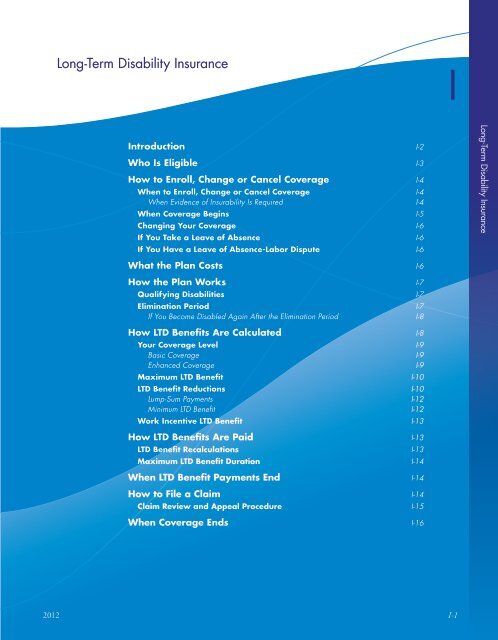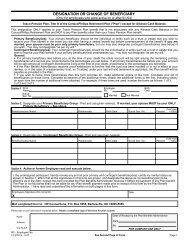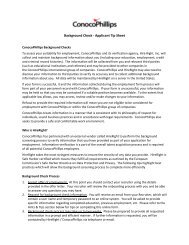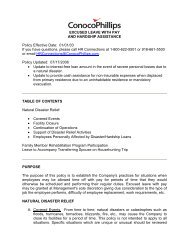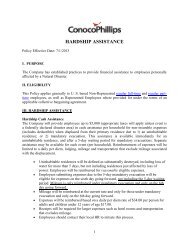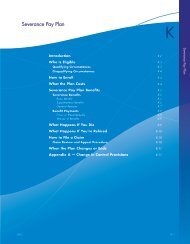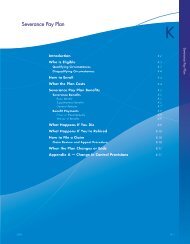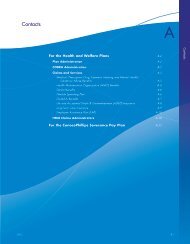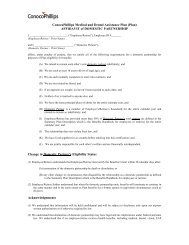Long-Term Disability Insurance - ConocoPhillips
Long-Term Disability Insurance - ConocoPhillips
Long-Term Disability Insurance - ConocoPhillips
Create successful ePaper yourself
Turn your PDF publications into a flip-book with our unique Google optimized e-Paper software.
<strong>Long</strong>-<strong>Term</strong> <strong>Disability</strong> <strong>Insurance</strong><br />
I<br />
Introduction I-2<br />
Who Is Eligible I-3<br />
How to Enroll, Change or Cancel Coverage I-4<br />
When to Enroll, Change or Cancel Coverage I-4<br />
When Evidence of Insurability Is Required I-4<br />
When Coverage Begins I-5<br />
Changing Your Coverage I-6<br />
If You Take a Leave of Absence I-6<br />
If You Have a Leave of Absence-Labor Dispute I-6<br />
<strong>Long</strong>-<strong>Term</strong> <strong>Disability</strong> <strong>Insurance</strong><br />
What the Plan Costs I-6<br />
How the Plan Works I-7<br />
Qualifying Disabilities I-7<br />
Elimination Period I-7<br />
If You Become Disabled Again After the Elimination Period I-8<br />
How LTD Benefits Are Calculated I-8<br />
Your Coverage Level I-9<br />
Basic Coverage I-9<br />
Enhanced Coverage I-9<br />
Maximum LTD Benefit I-10<br />
LTD Benefit Reductions I-10<br />
Lump-Sum Payments I-12<br />
Minimum LTD Benefit I-12<br />
Work Incentive LTD Benefit I-13<br />
How LTD Benefits Are Paid I-13<br />
LTD Benefit Recalculations I-13<br />
Maximum LTD Benefit Duration I-14<br />
When LTD Benefit Payments End I-14<br />
How to File a Claim I-14<br />
Claim Review and Appeal Procedure I-15<br />
When Coverage Ends I-16<br />
2012<br />
I-1
c Please refer to the Glossary<br />
beginning on page M-1<br />
for the definitions of<br />
underlined terms used<br />
throughout this SPD.<br />
p “Glossary,” page M-1<br />
In this chapter, the term<br />
“Company” refers to<br />
<strong>ConocoPhillips</strong> and the<br />
other companies that have<br />
adopted this Plan (as shown<br />
in “Employers Participating<br />
in the Plan” on this page).<br />
c This Plan is not in lieu of,<br />
and does not affect, any<br />
requirement for coverage<br />
by Workers’ Compensation<br />
insurance or any<br />
government-mandated<br />
temporary disability<br />
income benefits law.<br />
Introduction<br />
The <strong>ConocoPhillips</strong> <strong>Long</strong>-<strong>Term</strong> <strong>Disability</strong> (LTD) <strong>Insurance</strong> Plan (the Plan) can<br />
help replace a portion of your regular paycheck if serious illness or injury prevents<br />
you from working for an extended period of time (longer than 180 days). The Plan<br />
has been designed to provide valuable income protection at a competitive cost.<br />
You can choose from two levels of coverage — basic or enhanced. Both coverage<br />
levels pay monthly LTD benefits for a certain period of time while you’re disabled<br />
and unable to work as determined by the LTD Claims Administrator.<br />
EMPLOYERS PARTICIPATING IN THE PLAN<br />
As of Jan. 1, 2012, the most significant employers participating in the Plan are listed<br />
below. A complete current list of employers participating in the Plan may be<br />
obtained at any time, free of charge, from the Plan Administrator.<br />
> <strong>ConocoPhillips</strong> Company<br />
> <strong>ConocoPhillips</strong> Pipe Line Company<br />
> Phillips Utility Gas Corporation<br />
> <strong>ConocoPhillips</strong> Expatriate Services Corporation<br />
p “Plan Administration,” page L-5<br />
I-2 2012
Who Is Eligible<br />
STORE EMPLOYEES AND MEMBERS OF THE<br />
RIVERHEAD PIPELINE UNION<br />
Store employees and members of the Riverhead Pipeline<br />
Union are not eligible to participate in the <strong>Long</strong>-<strong>Term</strong><br />
<strong>Disability</strong> <strong>Insurance</strong> Plan.<br />
<strong>Long</strong>-<strong>Term</strong> <strong>Disability</strong> <strong>Insurance</strong><br />
IF YOU WERE DISABLED PRIOR TO JAN. 1, 2003<br />
OR JAN. 1, 2009<br />
If you were disabled prior to Jan. 1, 2003 (meaning<br />
that the first day of your “elimination period” was prior<br />
to Jan. 1, 2003) or if you became disabled prior to<br />
Jan. 1, 2009 while covered by a Burlington Resources<br />
Inc. LTD plan, the employer-sponsored LTD plan under<br />
which you had coverage on that day will apply. Please<br />
refer to your applicable LTD Summary Plan Description.<br />
If you’re an active, regular full-time or regular<br />
part-time 1 employee, you’re eligible to participate<br />
in the Plan if you’re:<br />
> A U.S. citizen or resident alien non-store employee<br />
working within or outside the U.S. (includes rotators<br />
and U.S. expats) who is paid on the direct U.S. dollar<br />
payroll 2 ; or<br />
> A U.S. citizen or resident alien non-store employee<br />
working within or outside the U.S. (includes rotators<br />
and U.S. expats) who is paid on the direct U.S. dollar<br />
payroll 2 and who is on a personal or disability leave<br />
of absence or on a family medical leave of absence.<br />
c Contact the Benefits Center for questions about whether<br />
your collective bargaining agreement expressly provides<br />
for your participation in the Plan.<br />
p “Contacts,” page A-1<br />
You’re not eligible to participate in the Plan if<br />
your classification isn’t described in this section.<br />
For example, temporary employees, independent<br />
contractors and commission agents aren’t eligible<br />
for the Plan.<br />
1<br />
Regular part-time employees must work on average at least 20 hours per week.<br />
2<br />
Direct U.S. dollar payroll means that payroll check is written in U.S. dollars by a U.S. company participating in the plan and is not converted to another currency<br />
before being paid to the employee.<br />
2012<br />
I-3
How to Enroll, Change or<br />
Cancel Coverage<br />
If you want to enroll in, change or cancel long-term<br />
disability coverage, you enroll online or call the<br />
Benefits Center. If you have questions about the<br />
enrollment procedure, contact the Benefits Center.<br />
p “Contacts,” page A-1<br />
When you enroll, you’ll:<br />
> Choose from the Plan options available to you; and<br />
> Authorize any required payroll deduction contributions<br />
for the coverage you select.<br />
Your enrollment materials will also contain information<br />
to help you make your enrollment elections. Contact<br />
the Benefits Center if you need more information.<br />
p “Contacts,” page A-1<br />
WHEN TO ENROLL, CHANGE OR CANCEL<br />
COVERAGE<br />
You can enroll, change or cancel coverage at any time.<br />
Evidence of insurability will be required if you enroll<br />
more than 30 calendar days after the date you’re first<br />
eligible for coverage and for certain coverage elections.<br />
p “When Evidence of Insurability Is Required,” below<br />
When Evidence of Insurability Is Required<br />
Evidence of insurability (EOI) — also known as<br />
evidence of good health — is required proof of your<br />
good health that must be approved by the Claims<br />
Administrator before you will be covered by the Plan.<br />
You must supply EOI if:<br />
> You elect coverage more than 30 calendar days after<br />
your eligibility date — that is, your hire date or the<br />
date you first become eligible;<br />
> You change your LTD Plan coverage from “basic” to<br />
“enhanced”; or<br />
> You re-enroll in the Plan upon your return from a<br />
leave of absence. If you are returning from a leave of<br />
absence-Labor Dispute, you’re automatically re-enrolled<br />
if the leave was 30 calendar days or less, and no EOI<br />
is required. If the leave of absence-Labor Dispute<br />
was more than 30 calendar days, you’ll be eligible<br />
for re-enrollment like a new hire, but EOI will not be<br />
required if you enroll within 30 calendar days and if<br />
the level of coverage is not increased. Note: You don’t<br />
need to provide EOI if you’re returning from a family<br />
medical leave of absence (FMLA), if you enroll in the<br />
same or a lower option as you had prior to going on<br />
your leave, and you enroll within 30 calendar days of<br />
your return to work. If you elect increased coverage<br />
after your return from any leave of absence, EOI will<br />
be required.<br />
I-4 2012
WHEN COVERAGE BEGINS<br />
The date your coverage begins depends on when you enroll.<br />
If you enroll or change your coverage:<br />
Within 30 calendar days of your eligibility date (e.g., your<br />
hire date or the date you first become eligible to participate)<br />
More than 30 calendar days after your eligibility date<br />
Coverage is effective:<br />
On your eligibility date<br />
On the first day of the month coincident with or following your<br />
enrollment and approval of any required EOI by the Claims<br />
Administrator<br />
<strong>Long</strong>-<strong>Term</strong> <strong>Disability</strong> <strong>Insurance</strong><br />
During annual enrollment 1<br />
Any other time during the year 1<br />
When you return to work as a regular full-time or regular<br />
part-time employee on or before the expiration of a leave of<br />
absence 2 and did not continue coverage during the leave<br />
When you return to work as a regular full-time or regular<br />
part-time employee on or before the expiration of a military<br />
leave of absence 2 , your coverage prior to the leave will<br />
automatically be reinstated without EOI<br />
When you return to work from a leave of absence-Labor Dispute<br />
of 30 or less calendar days, your coverage prior to the leave<br />
will automatically be reinstated without EOI. EOI is required<br />
for any additional LTD insurance<br />
When you return to work from a leave of absence-Labor Dispute<br />
of more than 30 calendar days, your coverage level prior to the<br />
leave will be available without EOI. EOI is required for any<br />
additional LTD insurance<br />
On the following Jan. 1 or the first day of the month coincident<br />
with or following your enrollment and approval of any required<br />
EOI by the Claims Administrator, whichever is later<br />
On the first day of the month coincident with or following your<br />
enrollment and approval of any required EOI by the Claims<br />
Administrator<br />
On the first day of the month coincident with or following your<br />
enrollment and approval of any required EOI by the Claims<br />
Administrator<br />
On the day you return to work<br />
On the day you return to work<br />
If you enroll WITHIN 30 calendar days of your eligibility date:<br />
On the day you return to work<br />
If you enroll MORE THAN 30 calendar days following your<br />
eligibility date: On the first day of the month coincident with<br />
or following your enrollment<br />
1<br />
You cannot increase coverage while you’re on a leave of absence.<br />
2<br />
See “If You Take a Leave of Absence” for further information on returning from a leave of absence.<br />
p “If You Take a Leave of Absence,” page I-6<br />
For all of the dates shown in the chart above, coverage begins only if you’re actively at work on that day. Otherwise,<br />
LTD Plan coverage will begin on the date you return to work for full pay on your normal schedule.<br />
2012<br />
I-5
CHANGING YOUR COVERAGE<br />
You can enroll in, change or cancel your LTD Plan<br />
elections at any time.<br />
> Your new elections won’t take effect until any required<br />
EOI has been accepted by the Claims Administrator.<br />
> Unless otherwise noted below, coverage changes will<br />
be effective on the first of the month coincident with<br />
or following your enrollment and approval of any<br />
required EOI.<br />
> Cancellation of coverage will be effective on the last<br />
day of the month in which the cancellation is received.<br />
IF YOU TAKE A LEAVE OF ABSENCE<br />
If you’re on a leave of absence (excluding a military<br />
leave of absence or a disability leave of absence because<br />
you are receiving LTD benefits), you may continue<br />
your LTD Plan coverage for a maximum of 12 months<br />
during the approved leave period — provided you<br />
make any required contributions for coverage when<br />
they’re due.<br />
> During your leave, you pay the same cost for coverage<br />
that an active employee would pay.<br />
– If you’re on a paid leave, your cost will continue to be<br />
deducted from your paycheck on an after-tax basis.<br />
– If you’re not receiving a paycheck from the<br />
Company, you’ll pay the costs to <strong>ConocoPhillips</strong> on<br />
an after-tax basis. (<strong>ConocoPhillips</strong> will bill you for<br />
the cost of coverage.)<br />
> When you return to work, the Company will resume<br />
deducting the costs from your paycheck on an<br />
after-tax basis.<br />
If you end your coverage while you’re away on leave —<br />
or if your coverage is ended due to non-payment<br />
of required contributions — you must submit an<br />
enrollment form and provide EOI upon your return<br />
to work. Note: If you return from a family medical<br />
leave of absence (FMLA) and enroll within 30 calendar<br />
days, you will not be required to provide EOI.<br />
p “Who Is Eligible,” page I-3; “How to Enroll, Change or<br />
Cancel Coverage,” page I-4<br />
c If You’re on a Military Leave of Absence<br />
Your LTD Plan coverage will be suspended until you return<br />
to work as an active employee.<br />
IF YOU HAVE A LEAVE OF ABSENCE-<br />
LABOR DISPUTE<br />
If you’re placed on a leave of absence-Labor Dispute,<br />
your long-term disability coverage will end on the last<br />
day of the month in which the leave begins. See the<br />
chart on page I-5 for coverage after you return to work.<br />
If you’re on a leave of absence-Labor Dispute during a<br />
regularly scheduled annual enrollment, you’ll not be<br />
eligible and a special annual enrollment period will be<br />
provided after you return from leave of absence-Labor<br />
Dispute.<br />
What the Plan Costs<br />
You pay the cost of your LTD Plan coverage with<br />
after-tax dollars. Your cost depends on:<br />
> Your pre-disability earnings; and<br />
> Whether you elect basic or enhanced coverage.<br />
When you enroll, you’ll receive information about how<br />
to access the current costs. The Plan Administrator<br />
reserves the right to recover any underpayments by<br />
the participant, made through error or otherwise, by<br />
offsetting future payments, invoicing the affected<br />
participant, or by other means as the Plan<br />
Administrator deems appropriate.<br />
During your elimination period, you must continue<br />
paying for your LTD coverage. This will ensure that<br />
you remain covered for any other disability that you<br />
may experience during the elimination period. You<br />
don’t pay for your coverage while you’re receiving<br />
LTD benefits for a disability.<br />
p “Elimination Period,” page I-7<br />
I-6 2012
How the Plan Works<br />
To qualify for LTD benefits, you must:<br />
> Be disabled, as defined below;<br />
> Be unable to work for at least 180 days after the last<br />
day you were able to work at your regular job with<br />
the Company (your elimination period); and<br />
p “Elimination Period,” at right<br />
> File a claim for LTD benefits with and be approved<br />
by the Claims Administrator.<br />
p “How to File a Claim,” page I-14<br />
QUALIFYING DISABILITIES<br />
“Disabled” or “disability” means that you’re receiving<br />
appropriate care and treatment from a physician on<br />
a continuing basis due to sickness, pregnancy or<br />
accidental injury; and<br />
> During your elimination period and the next<br />
24-month period, you’re unable to perform the material<br />
duties of your regular job with the Company and<br />
unable to earn more than 80% of your pre-disability<br />
earnings or indexed pre-disability earnings; or<br />
p “Elimination Period,” at right<br />
> After the 24-month period, you’re unable to earn more<br />
than 60% of your indexed pre-disability earnings from<br />
any employer in your local economy at any gainful<br />
occupation for which you’re reasonably qualified taking<br />
into account your training, education, experience and<br />
pre-disability earnings.<br />
Your loss of earnings must be a direct result of your<br />
sickness, pregnancy or accidental injury. The Claims<br />
Administrator has the sole authority for determining<br />
disability. Economic factors, such as, but not limited<br />
to, recession, job obsolescence, pay cuts and job-sharing<br />
won’t be considered in determining whether you meet<br />
the loss of earnings test. If your job requires a license,<br />
losing that license does not, in itself, constitute<br />
disability.<br />
You will not qualify for LTD benefits if your disability<br />
results from:<br />
> Commission of a felony;<br />
> Active participation in a riot;<br />
> Intentionally self-inflicted injury or attempted suicide;<br />
or<br />
> Any act of war — whether declared or undeclared —<br />
insurrection or rebellion.<br />
ELIMINATION PERIOD<br />
The “elimination period” is the 180-calendar day<br />
period that begins after the day you were last able to<br />
work at your regular job with the Company. You must<br />
be under the continuous care of a physician during<br />
your elimination period.<br />
If, at the end of the 180-day period:<br />
> You still have unused vacation, the 180-day period is<br />
extended until your vacation is exhausted;<br />
> You’re receiving or are eligible to receive 100% of<br />
pay under the Short-<strong>Term</strong> <strong>Disability</strong> (STD) Plan, the<br />
180-day period is extended until your 100% of pay<br />
benefits are exhausted; or<br />
p “Short-<strong>Term</strong> <strong>Disability</strong> Benefits,” page H-1<br />
> You’re receiving or are eligible to receive 60% of pay<br />
under the STD Plan, the 180-day period is extended<br />
until your 60% of pay benefits are exhausted.<br />
However, you may waive your remaining 60% of STD<br />
pay and begin receiving LTD benefits, if approved —<br />
unless the terms of a collective bargaining agreement<br />
don’t allow STD benefits to be waived.<br />
During the elimination period, no LTD benefits are<br />
payable under the LTD Plan.<br />
<strong>Long</strong>-<strong>Term</strong> <strong>Disability</strong> <strong>Insurance</strong><br />
2012<br />
I-7
c Returning to work DURING the elimination period (trial<br />
work days)<br />
> If you return to work for 30 days or less (does not<br />
have to be consecutive days) before completion of<br />
your elimination period, you won’t have to begin a new<br />
elimination period if you become disabled again from<br />
the same cause. Those workdays will apply toward<br />
the completion of your elimination period.<br />
> If you return to work for more than 30 days (does<br />
not have to be consecutive days) before completion of<br />
your elimination period, you will need to begin a new<br />
elimination period if you become disabled again from<br />
the same cause. Those workdays will not apply toward<br />
the completion of your new elimination period.<br />
> If you start an elimination period and return to work<br />
and then become disabled from a different cause,<br />
you must complete a new elimination period.<br />
p “Qualifying Disabilities,” page I-7<br />
If You Become Disabled Again After the<br />
Elimination Period<br />
If you have received at least one LTD benefit payment<br />
for a period of disability, recovered from the disability<br />
and returned to work, and then become disabled again,<br />
your elimination period is determined as follows:<br />
Contact the Claims Administrator if you have<br />
questions about how returning to work affects the<br />
elimination period.<br />
p “Contacts,” page A-1<br />
How LTD Benefits Are Calculated<br />
c See “supplemental retirement benefit” in the Glossary if<br />
you were an employee disabled (first day of elimination<br />
period) prior to April 15, 1991 under an LTD plan that<br />
was sponsored by Phillips Petroleum Company or its<br />
subsidiaries that adopted the Plan.<br />
p “Glossary,” page M-26<br />
Your LTD benefits are calculated based on your<br />
pre-disability earnings, your level of coverage (basic<br />
or enhanced) and your income from other sources<br />
(as described under “LTD Benefit Reductions” and<br />
“Work Incentive LTD Benefit”).<br />
p “LTD Benefit Reductions,” page I-10; “Work Incentive<br />
LTD Benefit,” page I-13<br />
> If you return to work for 180 days or less after<br />
completion of your elimination period, you won’t<br />
have to begin a new elimination period if you become<br />
disabled again from the same cause.<br />
> If you return to work but then stop working due<br />
to an unrelated disability, you must fulfill a new<br />
elimination period and be approved by the Claims<br />
Administrator as being disabled before LTD benefits<br />
will be payable for the new disability.<br />
> If a new disability occurs while you’re receiving LTD<br />
benefits, the new disability will be treated as part of<br />
the same period as your current disability. Monthly<br />
LTD benefits will continue while you remain disabled.<br />
The current disability for which you’re receiving LTD<br />
benefits and the new disability are subject to both<br />
the maximum LTD benefit duration and limitations/<br />
exclusions that apply to the new cause of disability.<br />
I-8 2012
YOUR COVERAGE LEVEL<br />
When you enroll in the LTD Plan, you elect either basic or enhanced coverage.<br />
Basic Coverage<br />
Basic coverage provides LTD benefits equal to 50% of your pre-disability earnings after you have completed the<br />
elimination period for as long as you’re qualified to receive LTD benefits (subject to the maximum LTD benefit<br />
duration).<br />
p “Elimination Period,” page I-7; “Maximum LTD Benefit Duration,” page I-14<br />
<strong>Long</strong>-<strong>Term</strong> <strong>Disability</strong> <strong>Insurance</strong><br />
BASIC COVERAGE CALCULATION EXAMPLE<br />
At the time he became disabled, Paul’s pre-disability earnings were $3,400 a month. During his disability, he is receiving<br />
Social Security disability benefits of $400 a month in addition to his LTD benefits. Here’s how Paul’s monthly LTD benefit is<br />
determined:<br />
Step 1 — Determine Total Monthly Income<br />
LTD benefit (50% of pre-disability earnings): $ 1,700 (50% x $3,400)<br />
Social Security disability benefit: + 400<br />
Total monthly income: $ 2,100<br />
Step 2 — Determine Earnings Limit<br />
70% of pre-disability earnings limit: $ 2,380 (70% x $3,400)<br />
Since the $2,100 total monthly income from the LTD Plan and Social Security is less than 70% of Paul’s pre-disability<br />
earnings, his LTD benefits are not reduced. Paul will receive a $1,700 monthly LTD benefit from the Plan and a $400<br />
monthly disability benefit from Social Security.<br />
Enhanced Coverage<br />
Enhanced coverage provides LTD benefits equal to 60% of your pre-disability earnings after you have completed<br />
the elimination period for as long as you’re qualified to receive LTD benefits (subject to the maximum LTD benefit<br />
duration).<br />
2012<br />
I-9
MAXIMUM LTD BENEFIT<br />
Your maximum LTD benefit may not exceed $40,000<br />
per month.<br />
LTD BENEFIT REDUCTIONS<br />
When added to the LTD benefit you receive from the<br />
Plan, your income from certain sources (as described<br />
below) cannot be more than 70% of your pre-disability<br />
earnings. If the total monthly income you receive from<br />
the Plan together with the other sources is over 70% of<br />
your pre-disability earnings, your LTD benefit will be<br />
reduced until the 70% ceiling is met.<br />
> Benefits under any other employer-sponsored group<br />
disability insurance plan (no offset for individual<br />
disability insurance that you purchase direct from<br />
the insurer);<br />
> Benefits under any other group health insurance<br />
policies that provide benefits for time away from work<br />
due to disability or under any group life policy that<br />
provides installment payments for permanent disability,<br />
if the Company contributes towards them or makes<br />
payroll deductions;<br />
> Entitlements under any mandatory benefit law, any<br />
Workers’ Compensation law, Maritime Maintenance &<br />
Cure law, occupational disease law or other similar law;<br />
> Any third-party liability judgment or settlement you<br />
receive for loss of income as a result of claims against<br />
a third party;<br />
> <strong>Disability</strong> entitlements from any federal, state,<br />
municipal or other governmental agency, including<br />
Canada;<br />
> The basic reparations portion of loss of income law<br />
providing for payments without determining fault in<br />
connection with automobile accidents — excluding any<br />
supplemental disability benefits you purchase under a<br />
no-fault auto law;<br />
> Benefits under any government-sponsored compulsory<br />
benefit program that provides payment for loss of time<br />
from your job because of your disability or from any<br />
other group disability income plan, fund or other<br />
arrangement, no matter what it’s called, if the<br />
Company contributes toward it or makes payroll<br />
deductions for it;<br />
> The estimated amount you’ll receive under Social<br />
Security (including those received on behalf of your<br />
dependents) or Workers’ Compensation if, at the time<br />
your LTD benefits begin, no final determination has<br />
been made about this LTD benefit. When the final<br />
determination is made, your LTD benefits will be<br />
recalculated, and any overpayment or underpayment<br />
will be corrected;<br />
> Commencement of benefits from a defined benefit<br />
retirement plan sponsored by a participating employer<br />
in this Plan. Your monthly LTD benefit will be<br />
reduced by the amount of the straight-life annuity<br />
(adjusted for early commencement in accordance<br />
with the retirement plan provisions, if applicable)<br />
that would be payable on your retirement plan benefit<br />
commencement date regardless of the form of benefit<br />
payment elected. If your retirement benefit includes<br />
an offset by a qualified domestic relations order, the<br />
straight-life annuity before the qualified domestic<br />
relations order offset will be used to reduce your<br />
monthly LTD benefit. The same reduction provisions<br />
apply if your retirement benefit is paid as an<br />
involuntary lump-sum payment (due to minimum<br />
retirement plan rules); or<br />
> Portions of payments you receive under the Plan’s work<br />
incentive provisions.<br />
p “Work Incentive LTD Benefit,” page I-13<br />
c If you became disabled (first day of elimination period) on<br />
Jan. 1, 2010 or after, Social Security payments you receive<br />
on behalf of your dependents will be included as an LTD<br />
benefit reduction when determining the 70% limit.<br />
In addition, if you became disabled (first day of elimination<br />
period) prior to April 15, 1991 under an LTD plan that was<br />
sponsored by Phillips Petroleum Company or its subsidiaries<br />
that adopted the Plan, Company-paid retirement benefits<br />
are not used in the LTD offset calculation.<br />
If you became disabled (first day of elimination period)<br />
between Jan. 1, 2003 and Dec. 31, 2009, and were<br />
enrolled in the enhanced option, you were eligible for<br />
a 50% benefit with an adjustment for inflation after<br />
24 monthly LTD benefit payments.<br />
If you became disabled (first day of elimination period)<br />
between Jan. 1, 2003 and Dec. 31, 2009, and were<br />
enrolled in either the basic or enhanced option, Social<br />
Security payments you received on behalf of your<br />
dependents were not included as an LTD benefit<br />
reduction when determining the 70% limit.<br />
I-10 2012
If your disability income from other sources is not paid monthly — for example, if they are paid quarterly or<br />
annually — they will be prorated to a monthly amount for purposes of calculating your LTD benefit.<br />
LTD BENEFIT REDUCTION EXAMPLE — BASIC COVERAGE<br />
At the time she became disabled, Lucy’s pre-disability earnings were $4,000 a month. She had received a $30,000<br />
Workers’ Compensation lump-sum benefit, which was deemed as being paid over 30 months (at $1,000 per month) in<br />
addition to her LTD benefits. Here’s how Lucy’s monthly LTD benefit is determined:<br />
Step 1 — Determine Total Monthly Income<br />
LTD benefit (50% of pre-disability earnings): $ 2,000 (50% x $4,000)<br />
Workers’ Compensation Award:<br />
+ 1,000 ($30,000 ÷ 30 months)<br />
Total monthly income: $ 3,000<br />
<strong>Long</strong>-<strong>Term</strong> <strong>Disability</strong> <strong>Insurance</strong><br />
Step 2 — Determine Earnings Limit<br />
70% of pre-disability earnings: $ 2,800 limit (70% x $4,000)<br />
Step 3 — Determine Excess Income<br />
Since the $3,000 total monthly income from the LTD Plan and Workers’ Compensation is greater than 70% of Lucy’s<br />
pre-disability earnings, her LTD benefit will be reduced.<br />
Total monthly income: $ 3,000<br />
70% of pre-disability earnings limit: – 2,800<br />
Excess income: $ 200<br />
Step 4 — Determine Final Net LTD Benefit<br />
LTD benefit (50% of pre-disability earnings): $ 2,000<br />
Excess income: – 200<br />
Final net LTD benefit: $ 1,800<br />
Lucy will receive a $1,800 monthly LTD benefit from the Plan and the award from Workers’ Compensation.<br />
2012<br />
I-11
Lump-Sum Payments<br />
For purposes of calculating your LTD benefit, any LTD benefit reductions<br />
that are paid as a lump sum (except retirement plan benefits) will be deemed<br />
as being paid over 30 months. The 30 months begins on the date you became<br />
disabled (the first day of elimination period), or the date upon which the<br />
lump-sum payment is made, whichever is later.<br />
p “Qualifying Disabilities,” page I-7<br />
If the amount calculated from the lump sum is greater than 50% of your pre-disability earnings, the lump sum will<br />
instead be divided by 50% of your pre-disability earnings to determine a greater number of months over which the<br />
lump sum will be prorated and deemed paid, as shown in the example below.<br />
LUMP-SUM PAYMENT EXAMPLE — BASIC COVERAGE<br />
At the time she became disabled, Lynne’s pre-disability earnings were $2,400 a month. In addition, she received a<br />
$48,000 lump-sum Workers’ Compensation settlement. For purposes of calculating LTD benefits, the settlement is deemed<br />
to be paid to her over 40 months, calculated as follows:<br />
Step 1 — Determine Usual 30-Month Period of Deemed Payment<br />
$48,000 settlement ÷ 30 months = $1,600 per month<br />
Step 2 — Determine Maximum Monthly Deemed Payment<br />
$2,400 pre-disability earnings x 50% = $1,200 per month<br />
Since the $1,600 per month deemed payment is greater than 50% of Lynne’s pre-disability earnings ($1,200 per<br />
month), the deemed payment needs to be recalculated.<br />
Step 3 — Recalculate Period of Deemed Payment<br />
$48,000 settlement ÷ $1,200 (50% of pre-disability earnings) = 40 months<br />
After 40 months of reduced LTD benefit payments, the deemed payment and offset will no longer apply and Lynne will be<br />
eligible to receive her original LTD benefit of $1,200, subject to Plan provisions.<br />
Minimum LTD Benefit<br />
Your LTD benefit won’t be less than 15% of your pre-disability earnings. However, this minimum won’t apply if<br />
you’ve been overpaid on your LTD Plan benefits or are receiving income from employment while you’re disabled.<br />
I-12 2012
WORK INCENTIVE LTD BENEFIT<br />
With the approval from the Claims Administrator and<br />
your physician you may participate in a rehabilitation<br />
program while you’re disabled and receiving LTD<br />
benefits. The Claims Administrator should be<br />
contacted in advance regarding any rehabilitation needs<br />
or plans. When you work while in a rehabilitation<br />
program, you’ll receive the sum of the following<br />
amounts:<br />
> Your monthly LTD benefit, which is reduced by 50%<br />
of employment earnings you earn while employed<br />
under the rehabilitation program; and<br />
> The amount you earn for working while disabled.<br />
If the amount you receive from the Plan, work<br />
incentive LTD benefits and the sources listed under<br />
“LTD Benefit Reductions” exceeds 100% of your<br />
pre-disability earnings or indexed pre-disability<br />
earnings, your monthly LTD benefit will be reduced<br />
by the amount that exceeds 100% of those earnings.<br />
Note: If your monthly LTD benefit is reduced because<br />
you’re receiving earnings from working while disabled,<br />
the 15% minimum LTD benefit won’t apply.<br />
p “LTD Benefit Reductions,” page I-10; “Minimum LTD<br />
Benefit,” page I-12<br />
How LTD Benefits Are Paid<br />
If the Claims Administrator determines that you<br />
qualify for LTD benefits under the Plan, your<br />
payments will begin on the first of the month after<br />
you complete your elimination period.<br />
p “Elimination Period,” page I-7<br />
Provided you remain disabled, subsequent LTD<br />
benefits will be paid to you on the first of each month<br />
and will represent payment for the period of the<br />
previous month. After you begin receiving LTD<br />
benefit payments, your monthly LTD benefit won’t<br />
be affected by termination of the Plan, termination<br />
of your coverage, or any Plan changes that become<br />
effective after the date you became disabled.<br />
p “Qualifying Disabilities,” page I-7<br />
If you’re disabled for only a part of a month, your LTD<br />
benefit payment for that month will be prorated to<br />
reflect the number of days you were disabled. Each<br />
month is counted as having 30 days, regardless of the<br />
actual number of days in a month.<br />
PRORATING EXAMPLE<br />
If your pre-disability earnings are $2,400, and you’re<br />
approved for LTD benefits beginning on April 11, your<br />
LTD benefit payment for April would be $800. That<br />
amount is calculated by taking your monthly LTD<br />
benefit of $1,200 (50% of your $2,400 pre-disability<br />
earnings), divided by 30 days ($40 per day), times the<br />
days of the month for which LTD benefits are paid (20).<br />
Twenty days at $40 per day equals $800.<br />
Because you pay for LTD coverage with after-tax<br />
dollars, any LTD benefits you receive from the insurer<br />
will not be taxable to you. (However, U.S. tax laws do<br />
change. If you receive LTD benefits under this Plan,<br />
you should consult with a tax professional when filing<br />
your income tax returns.)<br />
LTD BENEFIT RECALCULATIONS<br />
Your LTD benefit is recalculated each month. If you<br />
receive pay for work with <strong>ConocoPhillips</strong> or any other<br />
employer during one month, but not during the next<br />
month, your pay earned during the first month won’t<br />
reduce your monthly LTD benefit in the second<br />
month. However, if you work again later, pay earned<br />
in that month will be used to offset your future LTD<br />
benefits from the Plan.<br />
Remember, being gainfully employed while receiving<br />
LTD benefits, without prior approval from the Claims<br />
Administrator, could impact the amount of your LTD<br />
benefit. You must keep the Claims Administrator<br />
informed if you return to work in any capacity and at<br />
any job in order to receive the correct LTD benefits.<br />
<strong>Long</strong>-<strong>Term</strong> <strong>Disability</strong> <strong>Insurance</strong><br />
2012<br />
I-13
MAXIMUM LTD BENEFIT DURATION<br />
Your LTD benefit may not exceed these maximum<br />
durations:<br />
Age on <strong>Disability</strong><br />
Start Date Maximum LTD Benefit Duration 1<br />
Under age 60<br />
Age 60 and over<br />
To the end of the month in which you<br />
reach age 65<br />
60 months<br />
1<br />
If you became disabled (first day of elimination period) between April 15,<br />
1991 and Dec. 31, 2000 under an LTD plan that was sponsored by<br />
Phillips Petroleum Company or its subsidiaries that adopted the Plan,<br />
you are eligible for a lifetime LTD benefit (subject to applicable benefit<br />
reduction provisions) and are not subject to the above durations.<br />
c Concurrent Disabilities<br />
If a new, unrelated disability occurs while you’re receiving<br />
LTD benefits, the new disability will be under the same<br />
maximum LTD benefit period as your current disability.<br />
Both disabilities will be subject to all limitations and<br />
exclusions that apply to the new disability.<br />
When LTD Benefit Payments End<br />
LTD benefit payments end at the earliest of the<br />
following events:<br />
> The date you’re no longer disabled, as determined by<br />
the Claims Administrator;<br />
p “Qualifying Disabilities,” page I-7<br />
> The date you fail to provide the Claims Administrator<br />
with satisfactory proof of continuing disability;<br />
> The date you fail to attend a medical examination as<br />
requested by the Claims Administrator;<br />
> The date you reach the maximum LTD benefit<br />
duration; or<br />
p “Maximum LTD Benefit Duration,” above<br />
> The date of your death. If you die, unpaid LTD<br />
benefits for the month of your death will be paid<br />
in the following order:<br />
– To your spouse, if living;<br />
– To your children, if living, in equal shares; or<br />
– To your estate. If LTD benefits are payable to your<br />
estate, the Claims Administrator may pay up to<br />
$1,500 to someone related to you by blood or by<br />
marriage whom the Claims Administrator deems<br />
entitled to this amount. The Claims Administrator’s<br />
responsibility will be discharged to the extent of any<br />
payment made in good faith.<br />
How to File a Claim<br />
If you believe you may be disabled as defined by the<br />
Plan and expect your disability to continue beyond the<br />
end of the 180-day elimination period, you should file a<br />
notice of claim as soon as possible after your disability<br />
begins by contacting the Benefits Center. This will<br />
help avoid interruption of your income if you are<br />
approved for LTD benefits.<br />
p “Qualifying Disabilities,” page I-7; “Elimination<br />
Period,” page I-7<br />
c The Benefits Center is the initial point of contact for all<br />
notice of claim submissions under the LTD Plan. To file<br />
a notice of claim, you should contact the Benefits Center<br />
and provide the following information:<br />
> Your name,<br />
> Your Social Security number, and<br />
> Your last day worked.<br />
p “Contacts,” page A-1<br />
After your notice of claim has been filed, you’ll<br />
receive a “proof of disability” packet from the Claims<br />
Administrator. You and your physician(s) must<br />
complete the forms at your own expense and return<br />
them to the Claims Administrator no later than<br />
90 days after the end of your elimination period.<br />
The Claims Administrator may also require you to<br />
file supplemental proofs of claim at your expense and<br />
undergo physical examinations by a medical specialist<br />
of its choice at the Claims Administrator’s expense.<br />
If you do not provide satisfactory supplemental<br />
documentation within 60 days after the date the<br />
Claims Administrator asks for it, your claim may<br />
be denied.<br />
I-14 2012
The following documentation will be required:<br />
> Proof of disability — including, but not limited to, the<br />
date your disability started, the cause of your disability<br />
and the prognosis of your disability;<br />
> Proof of continuing disability;<br />
> Proof that you’re under the appropriate care and<br />
treatment of a physician throughout your disability;<br />
> Proof that you have applied for Social Security<br />
disability benefits until denied at the Administrative<br />
Law Judge level. The Claims Administrator provides<br />
assistance in this process; contact the Claims<br />
Administrator for information;<br />
p “Contacts,” page A-1<br />
> Proof that you have applied for Workers’ Compensation<br />
benefits or benefits under a similar law. If you don’t<br />
provide proof that you have applied for these benefits,<br />
the Claims Administrator may reduce your monthly<br />
LTD benefit. The reduction will be based on the<br />
Claims Administrator’s estimate of what you may be<br />
expected to receive;<br />
> Proof that you have applied, or are not eligible, for any<br />
of the amounts listed under “LTD Benefit Reductions.”<br />
If you don’t provide proof that you have applied for any<br />
of the items listed under “LTD Benefit Reductions,”<br />
the Claims Administrator may reduce your monthly<br />
LTD benefit;<br />
p “LTD Benefit Reductions,” page I-10<br />
> Information about any amounts that are listed under<br />
“LTD Benefit Reductions”; and<br />
> Any other material information related to your<br />
disability that may be requested by the Claims<br />
Administrator.<br />
c The Claims Administrator has been delegated total<br />
responsibility for determining LTD benefits under the<br />
Plan. Claims will be approved or denied by the Claims<br />
Administrator based on the terms of the LTD Plan,<br />
including the underlying insurance policy. Questions<br />
about LTD benefit claims should be directed to the<br />
Claims Administrator.<br />
p “Contacts,” page A-1<br />
When you file a claim with the Plan, you will be<br />
required to provide signed authorization to release<br />
medical and financial information to the Claims<br />
Administrator.<br />
p “Information and Consents Required From You,”<br />
page L-40<br />
CLAIM REVIEW AND APPEAL PROCEDURE<br />
For information about when to expect a response to<br />
your claim from the Claims Administrator and/or<br />
Appeals Administrator or how to file an appeal if your<br />
claim is denied, refer to the “Claims and Appeals<br />
Procedures” section.<br />
p “Claims and Appeals Procedures,” page L-35<br />
<strong>Long</strong>-<strong>Term</strong> <strong>Disability</strong> <strong>Insurance</strong><br />
LTD benefits are not payable for claims submitted<br />
more than one year after the date of your disability.<br />
However, you can request LTD benefits for late claims<br />
if you can show it was not reasonably possible for<br />
you to furnish proof of disability during the one-year<br />
period and you provided satisfactory proof as soon as<br />
reasonably possible.<br />
2012<br />
I-15
When Coverage Ends<br />
Your coverage will end on the earliest of the following<br />
events:<br />
> The last day of the month in which your employment<br />
ends for any other reason not stated in this section;<br />
> The last day of the month in which you no longer meet<br />
the Plan’s eligibility requirements;<br />
p “Who Is Eligible,” page I-3<br />
> The last day of the month in which your coverage is<br />
terminated for any reason;<br />
> The last day of the month in which you don’t make<br />
the required contributions;<br />
> The last day of the month in which you go on strike,<br />
are locked out or are laid off;<br />
> The last day of the month in which your leave of<br />
absence-Labor Dispute begins;<br />
> The date of your death; or<br />
> The date on which the LTD Plan is terminated.<br />
I-16 2012


